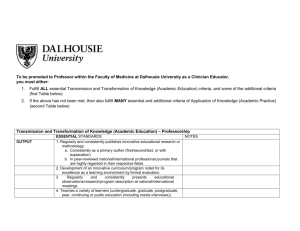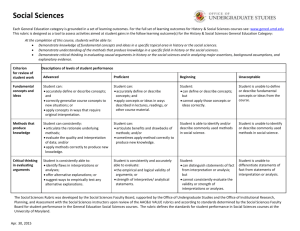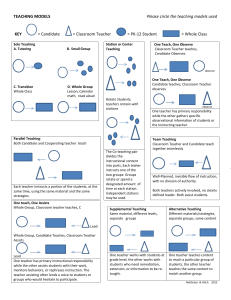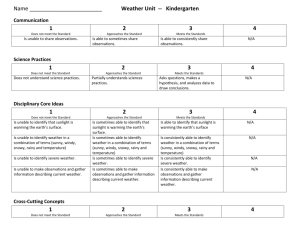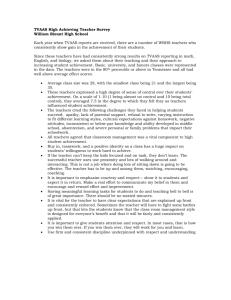Day 2 Co-Teaching FSC
advertisement
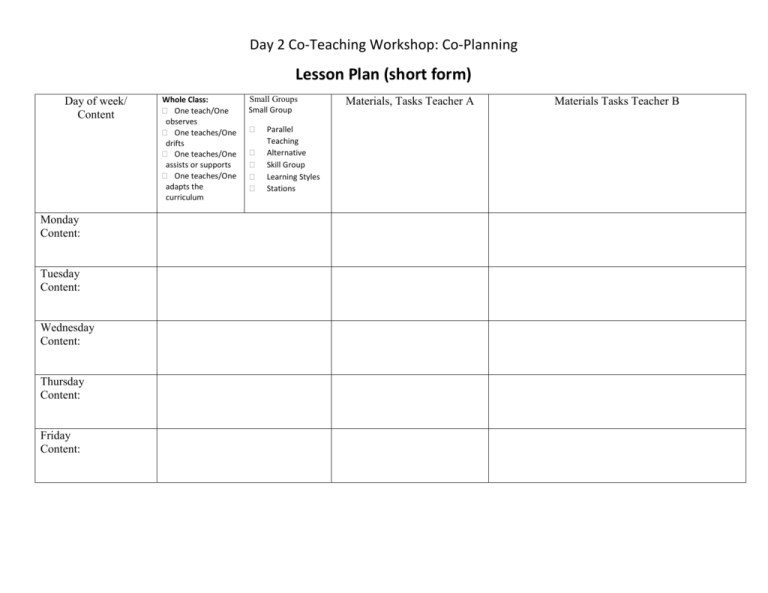
Day 2 Co-Teaching Workshop: Co-Planning Lesson Plan (short form) Day of week/ Content Monday Content: Tuesday Content: Wednesday Content: Thursday Content: Friday Content: Whole Class: One teach/One observes One teaches/One drifts One teaches/One assists or supports One teaches/One adapts the curriculum Small Groups Small Group Parallel Teaching Alternative Skill Group Learning Styles Stations Materials, Tasks Teacher A Materials Tasks Teacher B Lesson Plan (long form) Unit/Lesson Standard(s) (District or State) What students will know and be able to do at the end of the unit/lesson. Assessments: Formative: (observation, conference, quizzes, group work, rubrics) Summative: (test, performance-based task, etc.) Sequence of Lesson/Activities: How will you support and scaffold students’ learning as they move toward mastery? 1. Whole class introduction/mini-lesson, etc.: 2. Flexible group activities: 3. Wrap-up/Evaluation (exit slip, hand in work, observation, quiz, etc.) Co-teaching Model Supportive Model (Whole Class) Parallel Model (Small Groups) Complementary/Side-by-Side (Whole Class) Teacher A Responsibilities Teacher B Responsibilities Grouping Strategies (Seating Arrangements) Group A Students (identify by table, group, name) Group B Students (identify by table, group, name) Paraprofessional Role (Optional) Paraprofessional Materials (Optional) Accommodations, Modifications, and Materials for this unit/lesson Accommodations, Modifications, Materials for this unit/lesson Evaluation of Group A Evaluation for Group B Planning: Long-Term Team Goals Developmental Continuum of a High Performing Team Use this form to set goals and monitor progress—Use highlighter to indicate all descriptors that apply. Criteria Partnership Novice Begin Develop Begin to set goals using Co-Teaching Progress Rubric/Tracker Begin to clarify on roles and responsibilities using Teacher Skills Survey Begin to set standards for classroom routines, behavior using the Roles and Responsibilities Matrix Developing Fairly Generally Mainly Proficient Generally consistently Generally effectively Generally reliably Measure progress on goals fairly often and adequately Roles and Resp. getting clarified Norms generally observed Meetings mainly effective Problem solving protocol mainly works Daily/weekly communication plan mostly works Other: Measure goal progress generally consistently Roles and Resp. generally consistently clarified Norms observed generally consistently Meetings generally are effective Problem solving protocol works generally effectively Daily/weekly communication plan generally works reliably Other Develop daily/weekly communication plan Co-planning Begin to plan for full year’s meeting schedule Develop agenda format Develop Lesson Plan format (long form) The full year’s meeting schedule mainly works The agenda format mainly works Lesson Plan format (long form) mainly works Weekly lesson plan format (short form) mainly works High-Performing Team Consistently Mutually Wholly Naturally Goals are mutually shared and measured by each teacher and team consistently Roles and Resp. consistently clarified Norms observed consistently Meetings consistently effective Problem solving protocol works well consistently Daily/weekly communication plan consistently works efficiently Other The full year’s meeting The full year’s meeting schedule generally works schedule works effectively effectively and consistently and consistently The agenda format The agenda format works generally works effectively effectively and consistently and consistently Lesson Plan format (long form) works effectively and consistently Next Steps for HIGH priority Selecting NOTE: Date each comment Develop weekly lesson plan format (short form) Co-teaching Coassessing and cograding Models Used are Highlighted Whole Class: One teach/One observes One teaches/One drifts One teaches/One assists or supports One teaches/One adapts the curriculum Small Group Parallel Teaching Alternative Skill Group Learning Styles Stations Duet All models Begin to assess students’ work together and to set mutually agreed upon standards Begin to develop rubrics, scoring sheets together Lesson Plan format (long Weekly lesson plan format form) generally works (short form) works effectively and consistently effectively and consistently Weekly lesson plan format (short form) generally works effectively and consistently Models Used are Highlighted Models Used are Highlighted Models Used are Highlighted Whole Class: One teach/One observes One teaches/One drifts One teaches/One assists or supports One teaches/One adapts the curriculum Small Group Parallel Teaching Alternative Skill Group Learning Styles Stations Duet All models Assess all major assignments together Use mutually developed rubrics Rubrics can include modified work Whole Class: One teach/One observes One teaches/One drifts One teaches/One assists or supports One teaches/One adapts the curriculum Small Group Parallel Teaching Alternative Skill Group Learning Styles Stations Duet All models Assess together Use common rubrics Grade report cards and progress reports together Use results to plan for the next week or unit Whole Class: One teach/One observes One teaches/One drifts One teaches/One assists or supports One teaches/One adapts the curriculum Small Group Parallel Teaching Alternative Skill Group Learning Styles Stations Duet All models Assess together with rubrics that are mutually created Grade together Use classroom results to develop flexible groups and to modify instruction Using Data Improving Practice School-wide Inclusion Do report cards and progress reports together and mainly agree Examine standardized Student work is used at assessments, IEPs, and the end of each marking previous grades together period to assess the Use these assessments to effectiveness of teaching set goals and plan for year and to set goals for the next quarter This rubric is used to assess present state of and to assess growth in differentiating instruction, developing group work, formative assessment of student work to adjust curriculum, IEP goals, UDL, RtI and/or local or self-selected PD initiatives using the Co-Teaching Progress Rubric Co-teachers look at the status of school-wide inclusion: principal support, teacher attitudes, teacher support, time allotted, progress, needs for the week and for the year Consistently use classroom assessments formatively to modify groups and plans to differentiate instruction Begin to track at risk students’ progress Differentiating instruction is begun in parallel groupings include flexible groups that reflect need, interests, self-selection, learning styles, stations, etc. Co-teachers have begun to work on new-to-one or both co-teachers specific PD or initiatives The DI groupings are varied as need is demonstrated in the class. UdL, RtI, and/or specific local initiatives are generally employed in planning and teaching Co-teachers begin to discuss the status of school-wide inclusion with administrators and teachers Co-teachers provide regular feedback to administrators and teachers about the status of inclusion. They may provide workshops in the school. Data from observations, behavior, classroom assessments, qualitative and quantitative are used consistently and effectively to plan and to monitor student progress throughout the year. Universal Design for Learning, Differentiating Instruction, Response to Intervention, and other local or team-based PD are consistently to support effective teaching and progress monitoring for all students. Co-teachers advocate for inclusion and provide regular feedback to administrators and teachers about the status of inclusion. They may provide workshops in the school. Assessment: Differentiating Instruction Using Your Classroom Standards Goal for lesson, unit (Rubric) Rubric/Criteria List of students at each level Plan Results Basic Needs Imp. Proficient Advanced (re-teach) (reinforce) (next steps) (challenge)



